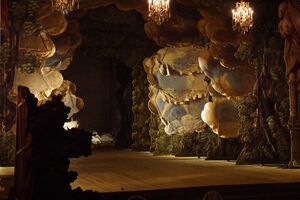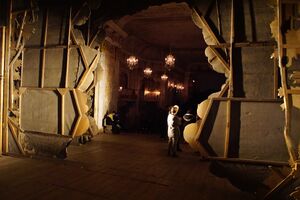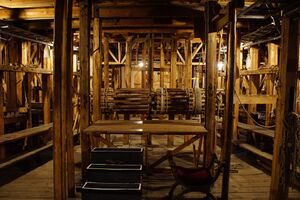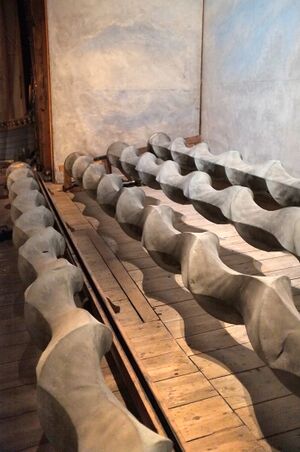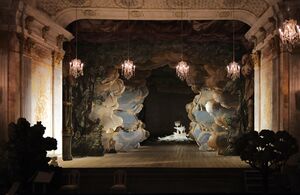Seas, skies and storms[edit]
Audiences of the Baroque era delighted in the depiction of nature, such as seascapes and storms, created by a combination of elaborate effects. De Loutherbourg’s Eidophusikon took such spectacle to its limit: a miniature theatre without actors.
In the Baroque period, theatres developed elaborate facilities to create illusionistic stage settings, representing a wide variety of locations, both imaginary and real. Theatres had a repertoire of stock scenes and effects, which could be used in different combinations, according to the needs of the play, opera, dance or spectacle being presented. In addition to various interiors and street scenes, garden, forest and sea scenes were common, as well as depictions of clouds through which heaven could be seen, or from which gods and angels descended. Machinery above, below and to the sides of the stage made it a highly dynamic environment, so that scenery and lighting could be changed, and actors and scenic elements could rise up, descend or roll onto the stage from the wings. The actual mechanics of these effects was always either hidden by the proscenium arch or the painted scenery, or disguised by additional scenic elements.
At the Drottningholm Court Theatre in Sweden (Q34), in addition to the machinery for mechanised scene changes (A.04), additional machinery enabled people and objects to be lowered from above, and raised up through the floor. Two of the flying machines raised and lowered vertically, while the third machine the movement was diagonal, as the platform could be raised or lowered while also moving sideways across the stage. To hide the ropes that supported the lifting platforms, it was also possible to lower clouds from the roof. The lines from these clouds were attached to drums of different diameters on a common drive shaft, so the clouds lowered at different rates. In this way, the clouds lowered in a simultaneous movement, apparently expanding to fill the sky, and surrounding the descending performers.
Under the stage floor, lifting platforms allowed the actor to enter the stage from below. To use this lift, it was first necessary to open a trap in the stage floor. A common design was to slide a section of the floor the same size as the lifting platform to the side, just below the stage floor. The rising platform then filled the space left by the sliding trap. As well as actors, scenic elements could be raised up through the floor, to surprise and delight the audience.
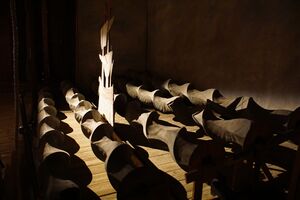
Methods were also developed to create the impression of sea waves, where ships sailed and sometimes even sank. At Drottningholm, five horizontal, screw-shaped cylinders with a diameter of about 40cm were located at the back of the stage, with a crank handle at the end. When the cylinders were rotated, they gave the illusion of rolling waves when viewed from the auditorium. Between the cylinders, it was possible to place a rail on which a model of a ship could be pulled sideways amongst the waves. Another technique to create the illusion of undulating waves was to use a rotating axle covered along its entire length with a strip of canvas painted as foaming waves. Ribs attached perpendicularly to the rotating axis pushed on the canvas from below, creating an undulating movement in the painted canvas. For a storm scene, the lowering clouds, the rolling waves, and the moving ship were supplemented with dimmed lighting (C.04) and a soundscape of wind, rain and thunder (D.04) to create a dramatic tableau vivant.
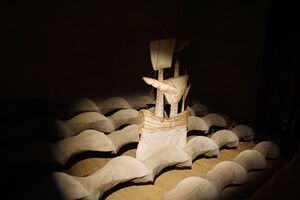
Towards the end of the 18th century, tastes were moving away from mythological and allegorical subjects, and towards the representation of scenes from life. In the 1780s the painter and scenic designer, Jacques-Philippe de Loutherbourg (Q30769) and the English actor, David Garrick (Q30768) created a large-scale miniature theatre in London called the Eidophusikon (Q30544). Presented on a stage around 2m wide and 2.5m deep, the Eidophusikon attempted the creation of a perfect illusion of natural reality: city- and landscapes at different times of day, and the drama of storms and volcanoes. Lighting, music, sound and staging effects animated the scenes, which unfolded over time, with the miniature stage making possible effects that were difficult or impossible at full size.
When the Eidophusikon was first presented, the programme included a dawn scene over London, noon in the port of Tangier, a scene of Naples, and moonlight over the Mediterranean. The final scene was a ‘Storm at Sea and Shipwreck’. In the Eidophusikon, scenography and stage effects were no longer in service to the drama, they were the drama; it was a stage without human actors, where light, sound, scenery and mechanics performed on their own terms. For audiences of the Baroque period, the recreation of nature on stage, its romantic beauty and drama, was central to the idea of theatre.
